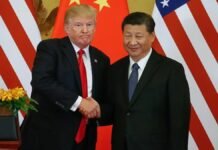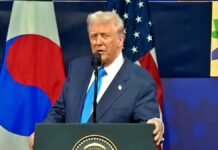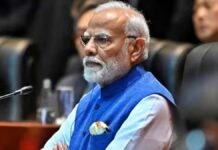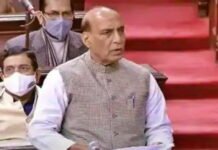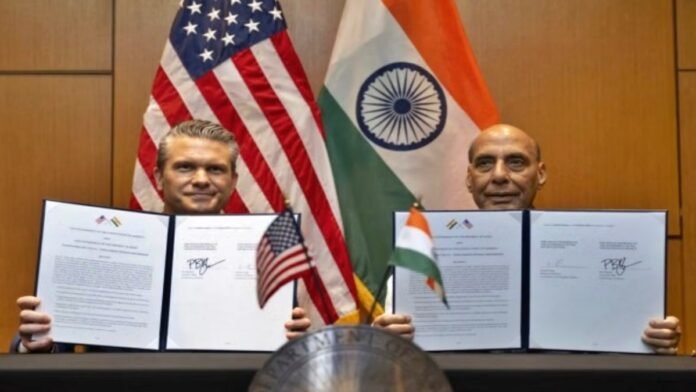
Key Points
- India and the United States signed a landmark 10-year “Framework for the US-India Major Defence Partnership” on Friday, October 31, 2025, in Kuala Lumpur during the ASEAN Defence Ministers’ Meeting-Plus (ADMM-Plus)
- Defence Minister Rajnath Singh and US Secretary of War Pete Hegseth held their first in-person meeting, describing the agreement as opening a “new chapter” in bilateral defense cooperation
- The framework focuses on enhancing coordination, information sharing, and technological cooperation, with both nations committing to maintain a free, open, and rules-based Indo-Pacific region
- US Defense Secretary Hegseth declared that “defense ties have never been stronger” between the two nations, calling the partnership “one of the most consequential” relationships in the world
- The signing comes amid ongoing trade negotiations between India and the US, and just days after External Affairs Minister S. Jaishankar met US Secretary of State Marco Rubio in Kuala Lumpur on October 27
New Delhi: India and the United States formalized a comprehensive 10-year defense framework agreement on Friday in Kuala Lumpur, marking a significant milestone in bilateral military cooperation. The historic pact was signed during the first in-person meeting between Defence Minister Rajnath Singh and US Secretary of War Pete Hegseth on the sidelines of the ASEAN Defence Ministers’ Meeting-Plus (ADMM-Plus), where Singh is representing India. The agreement establishes a decade-long roadmap for deeper military collaboration, capacity building, and joint initiatives across the Indo-Pacific region, reflecting the strategic convergence between the two democracies.
Historic First Meeting Between Defense Leaders
Defence Minister Rajnath Singh expressed his enthusiasm about meeting Secretary Hegseth in person after three prior telephonic conversations. “We have held telephonic conversations thrice. I am delighted to be meeting you in person on the sidelines of ADMM-Plus. On this occasion, I feel a new chapter will begin today with the signing of the Defence Framework. I am confident that under your leadership, India-US relations will further strengthen,” Singh stated during the meeting in the presence of senior officials from both countries. The warm exchange between the two leaders underscored the personal rapport and mutual respect that characterizes the India-US defense relationship.
Comprehensive Policy Direction for Defense Cooperation
Defence Minister Rajnath Singh emphasized that the newly signed framework would provide comprehensive policy direction to the entire spectrum of India-US defense relations for the next decade. In a post on social media platform X, Singh wrote, “Had a fruitful meeting with my US counterpart Peter Hegseth in Kuala Lumpur. We signed the 10-year ‘Framework for the US-India Major Defence Partnership’. This will usher in a new era in our already strong defence partnership. This Defence Framework will provide policy direction to the entire spectrum of the India-US Defence Relationship”. According to Singh, the document symbolizes the growing strategic convergence between the two nations and will herald a new decade of partnership based on shared democratic values and security interests.
Cornerstone for Regional Stability
US Secretary of War Pete Hegseth described the 10-year defense framework as a cornerstone for regional stability and deterrence in the Indo-Pacific region. In his statement on X following the meeting, Hegseth wrote, “I just met with @rajnathsingh to sign a 10-year U.S.-India Defense Framework. This advances our defense partnership, a cornerstone for regional stability and deterrence. We’re enhancing our coordination, info sharing, and tech cooperation. Our defense ties have never been stronger”. Hegseth also expressed gratitude to Minister Singh for the partnership, stating, “I want to express gratitude to Minister Singh for the partnership we have with India. It’s one of the most consequential US-India relationships in the world”.
Enhanced Coordination and Technology Transfer
The framework agreement specifically focuses on three critical areas of defense cooperation: enhanced coordination between military forces, expanded information sharing on security threats, and deepened technological cooperation, including defense manufacturing and co-production. These elements are designed to create interoperability between Indian and US military systems, facilitate joint operations, and enable India to access cutting-edge American defense technology. According to diplomatic sources, discussions during the meeting also covered India’s plans to procure advanced US military equipment and the establishment of new defense collaboration mechanisms.
Indo-Pacific Strategy and Rules-Based Order
Defence Minister Rajnath Singh emphasized that the India-US defense partnership plays a critical role in ensuring a free, open, and rules-based Indo-Pacific region. “Defence will remain a major pillar of our bilateral relations. Our partnership is critical for ensuring a free, open, and rules-based Indo-Pacific region,” Singh stated in his official communication. This commitment directly addresses growing concerns about China’s assertiveness in the South China Sea, where Beijing has deployed substantial coast guard fleets and interfered with the maritime activities of regional nations. The framework positions both nations as key guarantors of maritime security and international law in contested waters.
Diplomatic Momentum and High-Level Engagement
The defense framework signing represents the culmination of sustained high-level diplomatic engagement between India and the United States across multiple fronts. Just days before the defense ministers’ meeting, External Affairs Minister S. Jaishankar met US Secretary of State Marco Rubio in Kuala Lumpur on October 27, where the two leaders discussed bilateral relations, regional developments, and global challenges. Jaishankar shared on X, “Glad to meet @SecRubio this morning in Kuala Lumpur. Appreciated the discussion on our bilateral ties as well as regional and global issues”. These back-to-back meetings demonstrate the comprehensive nature of India-US strategic engagement, encompassing both defense and diplomatic dimensions.
Positive Signal Despite Trade Tensions
The signing of the defense framework sends a strong signal that both nations are prioritizing strategic cooperation despite ongoing trade negotiations and recent economic tensions. Last week, Union Commerce and Industry Minister Piyush Goyal stated that India would not enter into any trade agreement “in haste” or accept conditions from partner nations that could limit its “trading choices,” indicating some friction in economic talks. However, the defense agreement demonstrates that both governments recognize the overriding importance of security cooperation, particularly in light of shared concerns about China’s regional ambitions and the need for collective deterrence.
Marco Rubio’s Reassurance on Pakistan Ties
Prior to the defense framework signing, US Secretary of State Marco Rubio provided important reassurance about America’s approach to South Asian partnerships. Ahead of his meeting with Jaishankar, Rubio described US-India relations as “deep, historic and important” and explicitly stated that America’s ties with Pakistan do not come at the expense of its “relationship” and “friendship” with India. This clarification addresses long-standing Indian concerns about US military assistance to Pakistan and signals Washington’s recognition of India as its primary strategic partner in South Asia.
ASEAN Context and Regional Security Architecture
The signing ceremony took place within the broader context of the ASEAN Defence Ministers’ Meeting-Plus, which brings together defense chiefs from ASEAN nations and dialogue partners, including the United States, India, China, Australia, Japan, New Zealand, South Korea, and Russia. Ahead of his visit, Defence Minister Rajnath Singh had emphasized that the ASEAN-India engagements in Kuala Lumpur aim to further strengthen defense and security cooperation among ASEAN member states and India, in line with India’s ‘Act East Policy’. The multilateral setting provided an ideal backdrop for formalizing the bilateral India-US framework while demonstrating both nations’ commitment to the regional security architecture.
Pentagon Chief’s Regional Engagement
During his visit, US Defense Secretary Pete Hegseth is engaging in multiple bilateral meetings with defense ministers from nations including Indonesia, the Philippines, Thailand, and China, as Washington seeks to strengthen security ties amid growing regional tensions. On Thursday, Hegseth met with Malaysia’s defense minister, and both officials underscored their commitment to maritime security in the contentious South China Sea. These parallel diplomatic efforts complement the India-US framework by building a network of security partnerships that collectively enhance deterrence and promote stability across the Indo-Pacific.
Strategic Convergence and China Balancing
Defense analysts view the 10-year framework as an important component of efforts to balance China’s growing military and economic influence in the Indo-Pacific region. The agreement strengthens the regional security architecture by deepening military interoperability between the world’s largest democracy and its oldest democracy, creating a formidable partnership capable of responding to security challenges. The framework’s emphasis on a “rules-based” Indo-Pacific directly challenges China’s approach in disputed maritime zones, where Beijing has frequently violated international law and intimidated smaller nations.
Foundation for Next Decade of Partnership
The comprehensive nature of the framework establishes it as the foundational document governing all aspects of India-US defense cooperation for the next decade. Unlike previous agreements that focused on specific defense transactions or limited cooperation areas, this framework provides overarching policy guidance that will facilitate seamless defense collaboration across multiple domains, including joint exercises, intelligence sharing, defense technology co-development, military training exchanges, and strategic planning. The 10-year timeline ensures continuity regardless of political transitions in either country, providing stability and predictability to defense planners and industry partners in both nations.
Bilateral Relations at Historic High
The successful conclusion of the defense framework agreement reflects the transformation of India-US relations from estrangement during the Cold War era to today’s comprehensive global strategic partnership. Defence cooperation has emerged as the most dynamic pillar of bilateral relations, with both nations regularly conducting joint military exercises across all three services, India becoming a Major Defense Partner of the United States, and defense trade growing exponentially over the past two decades. The new framework institutionalizes this progress and provides a clear pathway for even deeper integration of defense capabilities over the coming decade.








